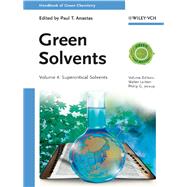
Note: Supplemental materials are not guaranteed with Rental or Used book purchases.
Purchase Benefits
Looking to rent a book? Rent Green Solvents, Volume 4 Supercritical Solvents [ISBN: 9783527325900] for the semester, quarter, and short term or search our site for other textbooks by Anastas, Paul T.; Leitner, Walter; Jessop, Philip G.. Renting a textbook can save you up to 90% from the cost of buying.
Foreword V
Preface XV
About the editors XIX
List of Contributors XXI
1 Introduction 1
Philip Jessop and Walter Leitner
1.1 What is a Supercritical Fluid (SCF)? 1
1.2 Practical Aspects of Reactions in Supercritical Fluids 4
1.3 The Motivation for Use of SCFs in Modern Chemical Synthesis 6
1.4 The History and Applications of SCFs 9
2 High-pressure Methods and Equipment 31
Nils Theyssen, Katherine Scovell, and Martyn Poliakoff
2.1 Introduction 31
2.2 Infrastructure for High-pressure Experiments 32
2.3 High-pressure Reactors 34
2.4 Auxiliary Equipment and Handling 45
2.5 Dosage Under a High-pressure Regime 58
2.6 Further Regulations and Control in Flow Systems 64
2.7 Evaporation and Condensation 66
2.8 Complete Reactor Systems for Synthesis with SCFs 67
2.9 Conclusion 73
References 73
3 Basic Physical Properties, Phase Behavior and Solubility 77
Neil R. Foster, Frank P. Lucien, and Raffaella Mammucari
3.1 Introduction 77
3.2 Basic Physical Properties of Supercritical Fluids 77
3.3 Phase Behavior in High-Pressure Systems 86
3.4 Factors Affecting Solubility in Supercritical Fluids 92
4 Expanded Liquid Phases in Catalysis: Gas-expanded Liquids and Liquid–Supercritical Fluid Biphasic Systems 101
Ulrich Hintermair, Walter Leitner, and Philip Jessop
4.1 A Practical Classification of Biphasic Systems Consisting of Liquids and Compressed Gases for Multiphase Catalysis 101
4.2 Physical Properties of Expanded Liquid Phases 106
4.3 Chemisorption of Gases in Liquids and their Use for Synthesis and Catalysis 120
4.4 Using Gas-expanded Liquids for Catalysis 129
4.5 Why Perform Liquid–SCF Biphasic Reactions? 150
4.6 Biphasic Liquid–SCF Systems 159
4.7 Biphasic Reactions in Emulsions 172
References 175
5 Synthetic Organic Chemistry in Supercritical Fluids 189
Christopher M. Rayner, Paul M. Rose, and Douglas C. Barnes
5.1 Introduction 189
5.2 Hydrogenation in Supercritical Fluids 190
5.3 Hydroformylation and Related Reactions in Supercritical Fluids 202
5.4 Oxidation Reactions in Supercritical Fluids 205
5.5 Palladium-mediated Coupling Reactions in Supercritical Fluids 208
5.6 Miscellaneous Catalytic Reactions in Supercritical Fluids 214
5.7 Cycloaddition Reactions in Supercritical Fluids 221
5.8 Photochemical Reactions in Supercritical Fluids 224
5.9 Radical Reactions in Supercritical Fluids 228
5.10 Biotransformations in Supercritical Fluids 229
5.11 Conclusion 234
References 235
6 Heterogeneous Catalysis 243
Roger Gläser
6.1 Introduction and Scope 243
6.2 General Aspects of Heterogeneous Catalysis in SCFs and GXLs 244
6.3 Selected Examples of Heterogeneously Catalyzed Conversions in SCFs and GXLs 252
6.4 Outlook 273
References 274
7 Enzymatic Catalysis 281
Pedro Lozano, Teresa De Diego, and José L. Iborra
7.1 Enzymes in Non-aqueous Environments 281
7.2 Supercritical Fluids for Enzyme Catalysis 283
7.3 Enzymatic Reactions in Supercritical Fluids 285
7.4 Reaction Parameters in Supercritical Biocatalysis 289
7.5 Stabilized Enzymes for Supercritical Biocatalysis 292
7.6 Enzymatic Catalysis in IL–scCO2 Biphasic Systems 294
7.7 Future Trends 298
References 298
8 Polymerization in Supercritical Carbon Dioxide 303
Uwe Beginn
8.1 General Aspects 303
8.2 Polymerization in scCO2 315
8.3 Conclusion 352
References 353
9 Synthesis of Nanomaterials 369
Zhimin Liu and Buxing Han
9.1 Introduction 369
9.2 Metal and Semiconductor Nanocrystals 369
9.3 Metal Oxide Nanoparticles 377
9.4 Carbon Nanomaterials 383
9.5 Nanocomposites 385
9.6 Conclusion 393
References 394
10 Photochemical and Photo-induced Reactions in Supercritical Fluid Solvents 399
James M. Tanko
10.1 Introduction 399
10.2 Photochemical Reactions in Supercritical Fluid Solvents 403
10.3 Photo-initiated Radical Chain Reactions in Supercritical
Fluid Solvents 410
10.4 Conclusion 414
References 415
11 Electrochemical Reactions 419
Patricia Ann Mabrouk
11.1 Introduction 419
11.2 Electrochemical Methods 419
11.3 Analytes 420
11.4 Electrolytes 421
11.5 Electrochemical Cell and Supercritical Fluid Delivery System 421
11.6 Electrodes 422
11.7 Solvents 423
11.8 Applications 429
11.9 Conclusion and Outlook 431
References 431
12 Coupling Reactions and Separation in Tunable Fluids: Phase Transfer-Catalysis and Acid-catalyzed Reactions 435
Pamela Pollet, Jason P. Hallett, Charles A. Eckert, and Charles L. Liotta
12.1 Introduction 435
12.2 Phase Transfer Catalysis 435
12.3 Near-critical Water 438
12.4 Alkylcarbonic Acids 448
12.5 Conclusion 453
References 454
13 Chemistry in Near- and Supercritical Water 457
Andrea Kruse and G. Herbert Vogel
13.1 Introduction 457
13.2 Properties 457
13.3 Synthesis Reactions 459
13.4 Biomass Conversion 465
13.5 Supercritical Water Oxidation (SCWO) 470
13.6 Inorganic Compounds in NSCW 471
13.7 Conclusion 472
13.8 Future Trends 473
References 473
Index 477
The New copy of this book will include any supplemental materials advertised. Please check the title of the book to determine if it should include any access cards, study guides, lab manuals, CDs, etc.
The Used, Rental and eBook copies of this book are not guaranteed to include any supplemental materials. Typically, only the book itself is included. This is true even if the title states it includes any access cards, study guides, lab manuals, CDs, etc.